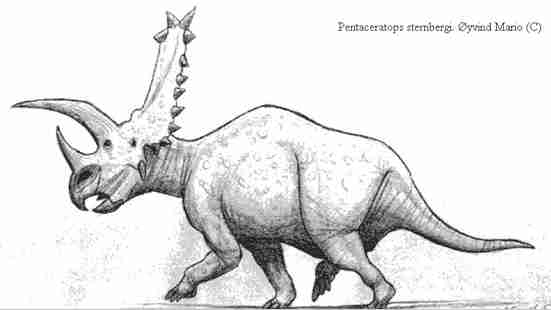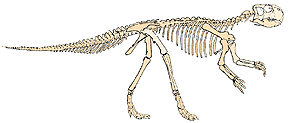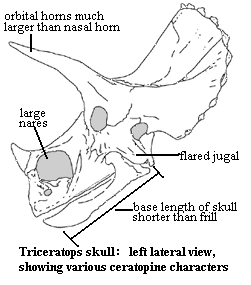
Pentaceratops sternbergi - (drawing copyright Øyvind M. Padron)
| Ornithischia | ||
| The Vertebrates | Ceratopsia |
| Vertebrates Home | Vertebrate | Vertebrate |
|
Abbreviated Dendrogram
Dinosauromorpha
├─┬─Theropoda
│ └─Sauropodomorpha
│
└─Ornithischia
├─Thyreophora
│ ├─Stegosauria
│ └─Ankylosauria
└─Cerapoda
├─Ornithopoda
│ ╞═Hypsilophodontidae
│ └─Hadrosauridae
└─┬─Heterodontosauridae
└─Marginocephalia
├─Pachycephalosauria
└─Ceratopsia
├─Psittacosauridae
└─┬─Protoceratopsidae
└─┬─Centrosaurinae
└─Ceratopsinae
|
Contents
Overview |
|
|
|
Pentaceratops sternbergi - (drawing copyright Øyvind M. Padron) |
Ceratopsia - horned dinosaurs, small to large parrot-beaked dinosaurs, divided into the primitive early Psittacosauridae - parrot-beaked dinosaurs, stocky animals about about 1.5 meters long, and the Neoceratopsia or horned dinosaurs, including both horned and hornless types, all equipped with a bony frill, and the medium-sized to larger ones quadrapedal. Included here area number of famous late Cretaceous types like Styracosaurus, Triceratops, etc.
The Ceratopsians were the last of the major dinosaurian groups to evolve; first appearing during the Aptian or Albian. They are also among the most geographically limited, none being known outside the Asiamerican eastern Asia + western North America) landmass. Reputed "Neoceratopsia" from Mid-Cretaceous southern Australia are probably not of this group. They may pertain to an unknown lineage of herbivorous quadrapedal Gondwanaland Predentata. Only the very most specialised Ceratopsia (the family Ceratopsidae, known only from the Senonian of western North America) developed horns and grew to a large size. (Triceratops horridus was about the size of a modern elephant).
Ceratopsia: ~Ceratopia Marsh
Early to Late Cretaceous of Asia & North America.
Marginocephalia: Pachycephalosauria + * : Psittacosauridae + (Protoceratopsidae + (Centrosaurinae + Ceratopsinae).
Unique single rostral bone, usually with rugose surface indicated horn beak; maxilla at least 2/3 as tall as length; broad, inflexible mandibular symphysis (i.e. where mandibles grow together); jaw typically narrow, with flaring jugal (so skull triangular in dorsal view); tall snout w relatively broad premaxilla. Commonly parietal shelf (not necessarily a frill) overhanging occipital skull; often nasal & supraorbital horns. Teeth replaced very rapidly; achieved scissor-like vertical shear & high coronoid process gave additional leverage on lower jaw. Shelf may have started as giving increased length to mandibular adductor muscles. Presumably served in more derived species for display and possibly defense.
Links: dinodata.
 Psittacosauridae:
Psittacosaurus (= Protiguanodon).
Psittacosauridae:
Psittacosaurus (= Protiguanodon).
Early Cretaceous of Asia.
Ceratopsia: Protoceratopsidae + Centrosaurinae + Ceratopsinae)) + *.
1-2m early ceratopsian. Enamel primarily on one side of teeth, for upper teeth, thickened side is on the outside, reverse on lower teeth, cerating self-sharpening effect; crowns of even hatchlings show shear wear; tall, parrot-like snout with neomorphic unpaired rostral bone inserted between premaxillae (opposes predentary); nares high; anteriorly vaulted palate; distance from orbit to front of skull <40% of skull length, shortest of all dinosaurs (even oviraptors??); nasal extends as processes ventral to nares; premaxilla forms lateral surface of snout, broadly separating maxilla from nares; antorbital fenestrae and fossae absent; elongated jugal; slight parietal frill; post-cranial skeleton similar to basic Ornithischian pattern, especially Hypsilophodonts; moderately long, outstretched tail stiffened by (sometimes ossified) tendons along spine; arms ~58% length of legs; likely facultative biped; $ 2 outer digits of manus reduced; manual unguals expanded & slightly hoof-like; tibia » femur (cursorial); 4 functional digits on pes; gastroliths common unlike derived Ceratopsians); skin impressions broadly similar to other Ornithischia.
Links: DinoData: Psittacosauridae; Psittacosaurus- ZoomDinosaurs.com; Lectures 12: Early Cretaceous; Psittacosaurus mongoliensis; New Page 6; DINOBASE, Sibbick's dinosaur pictures; ?????? Vertebrates (Chinese); Ornithischia; Biologybase: Checklist of the Non-Avian Dinosaurs; Psittacosaurus The Natural History Museum's Dino Directory. ATW020118.
Protoceratopsidae: Leptoceratops, Protoceratops.
Late Cretaceous of Asia & North America.
Ceratopsia:: Centrosaurinae + Ceratopsinae) + *.
Unclear whether clade or grade. No orbital or developed nasal horns; Rare in NAm, common in Asia.
Links: Paleo Mont Park; Fighting Dinosaurs.
Centrosaurinae: Styracosaurus.
Late Cretaceous of North America.
Ceratopsia::: Ceratopsinae + *.
Long nasal horns, hooks & processes on parietals; short, square squamosals; bone "finger" projecting into back of nares; in some, orbital & nasal horns appear as irregular, thickened bone pads (for horn spikes?); divergent ornamentation developed as approaching adulthood -- young of all species appear the same. Bone-beds common -- perhaps herds.
Links: DinoData: Centrosaurinae; Centrosaurus nasicornis.
 Ceratopsinae = Chasmosaurinae): Chasmosaurus, Torosaurus, Triceratops.
Ceratopsinae = Chasmosaurinae): Chasmosaurus, Torosaurus, Triceratops.
Late Cretaceous of North America.
Ceratopsia::: Centrosaurinae + *.
Up to 8m (generally larger than centrosaurs), with skull up to 2.5 m. Complex, large narial opening with many fenestrae and bone processes; short nasal and long orbital horns; snout relatively short; neotenous epinasal bone on ant of nasal horn; some (e.g. Triceratops) had frontal sinus between horns and braincase, possibly used as shock absorber in combats (as in bovids) or as part of extensive system of vascularized cavities in thermoregulation; large conical epijugal horn on flared cheek; spikes absent from parietal (? Triceratops had epoccipitals as shown); frill longer than basal length of skull, with bend in middle (secondary reduction in Triceratops); squamosal concave and extends full length of frill; no known bone beds found solitary?).
Links: DinoData: Chasmosaurinae; Biologybase: Checklist of the Non-Avian Dinosaurs; Abstract: Marcot; Chasmosaurinae; Literature - Ceratopsia; Ceratopsinae -- The Dinosauricon; The Evolution of Dinosaurs; GEOL 104 Dinosaurs- A Natural History; Torosaurus Fact Sheet - EnchantedLearning.com; GEOL 104 Lecture 20- Marginocephalia- That's using your head!; Adrian's Dinosaur Notes Page ( For Dr. Masons g180 Class ); Figure 5; Triceratops. ATW030125.
checked ATW060107